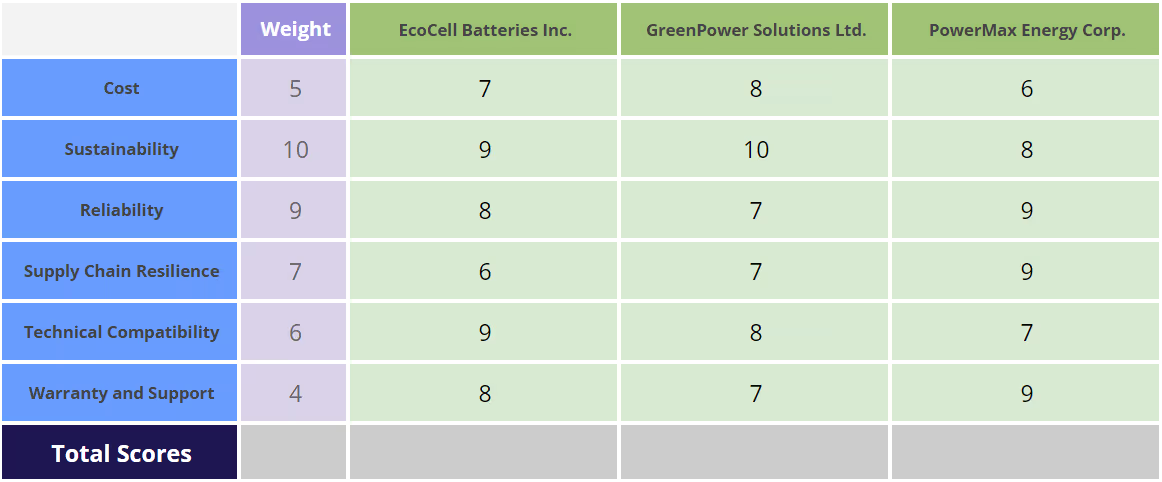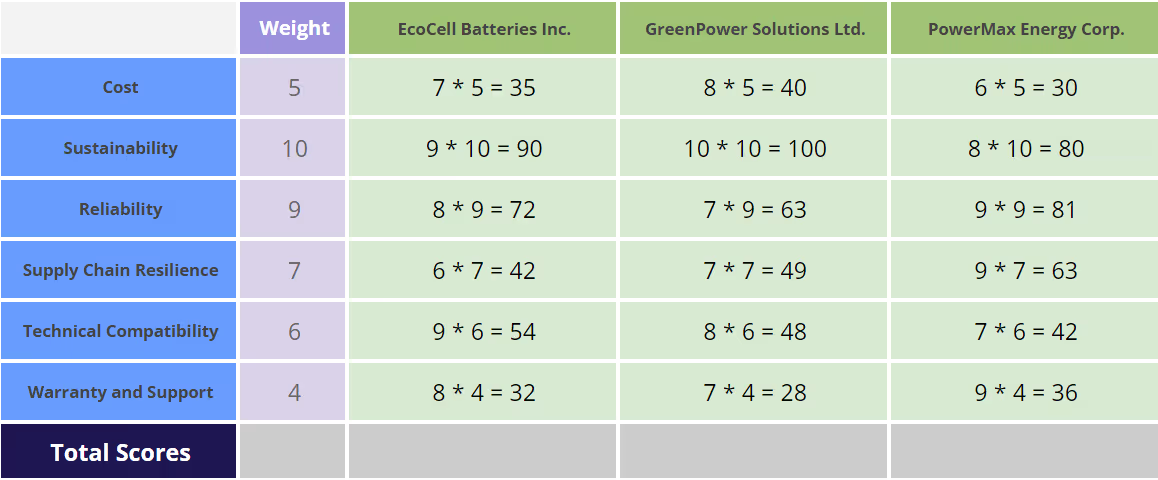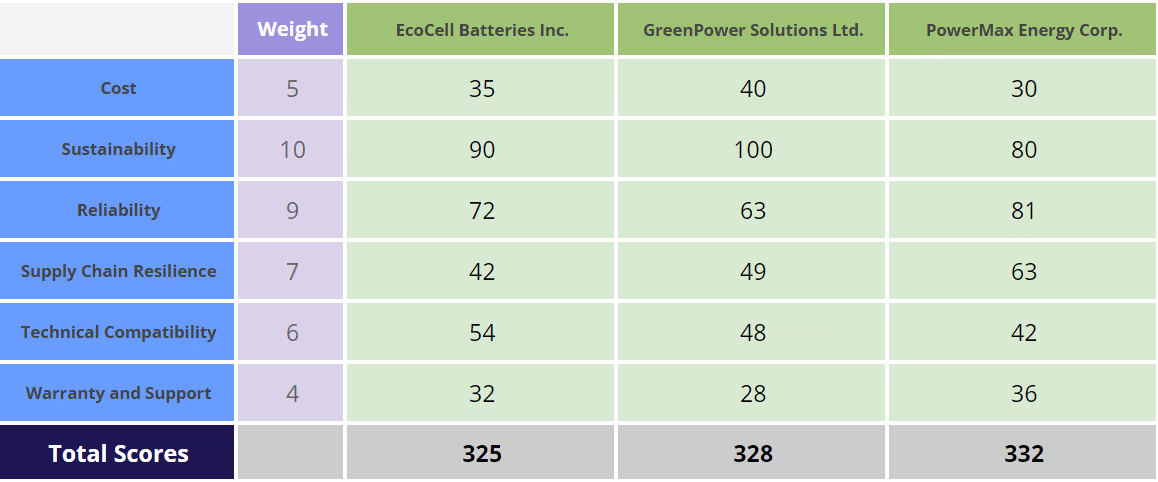Is it a headache to make important decisions in your business? We know how you feel. The average business leader spends close to 40% of their time on business decisions—and most of that time is wasted.
Thankfully, we’ve got something that can flip the script for any business leader. You can stop pulling out your hair and save more time using a decision matrix. (A what now?)
Stay with us for the next couple of minutes, and here’s what you’ll learn:
- What Is A Decision Matrix?
- Why Do You Need A Decision Matrix?
- When Should You Use A Decision Matrix?
- Decision Matrix Example And Framework In 7 Steps
By the end of this article, you’ll understand everything you need to know about how to make the right decision every time.
What Is A Decision Matrix?
A decision matrix is an opportunity analysis tool that uses weighted criteria to evaluate and choose between multiple options. In other words, it is a useful tool that helps you weigh up the best options, assess the important factors, and make the right choice based on logic, not emotion.
Other names for a decision matrix include decision grid, problem selection matrix, Pugh matrix, solution matrix, grid analysis, weighted decision matrix, criteria rating form, and criteria-based matrix.
So, apart from having more aliases than a spy, a decision matrix is a useful business tool. The big question is: how does it work?
In a nutshell, your team brainstorms key criteria and then applies weighted scores to each option based on relative importance. This methodology helps you take a logical approach to determine the best decision (based on the highest score).
Why Do You Need A Decision Matrix?
Sometimes, leaders get frozen in analysis paralysis, bewildered by 37 half-baked ideas from the last meeting.
It doesn't matter how pretty and colorful your Excel spreadsheet looks if you're still stuck. In the end, you need to cut the noise and get total clarity on the best road forward.
Here are six benefits of using a decision matrix:
- Offers more clarity. When you use a decision matrix, you have one source of truth instead of many. This structure and clarity in your decision-making process allow your team to focus and close the planning-to-execution gap in real time.
- Enhances team alignment. You have a system that keeps everyone on track to approach their work in a way that aligns with your organizational goals. Put simply: you get fast, impactful action and better outcomes.
- Improves collaboration. Instead of a small group of cult leaders making all the big decisions, you give everyone a voice. Everyone in your company should be involved in decisions.
- Better informed decisions. The democratic approach to strategy and decision-making opens the table to more valuable employee feedback. You can get input from multiple perspectives and source great ideas from many people instead of just a few.
- Faster progress. If you want to keep up with your competitors in this fast and frenzied world, your organization needs to act fast. Innovation is driven by quick, confident decision-makers.
- High-ROI activity. Just like a decision tree or the Eisenhower matrix, this decision-making tool is a low-cost activity you can perform quickly and easily. Despite its simplicity, it helps you make a quick final decision that makes the most sense.
At its core, a decision matrix is a human-centric approach to business. The pressure is on the problem, not the people—and no one’s left out.
When Should You Use A Decision Matrix?
The decision matrix method is not for every little dilemma you face. It's most effective when you need to pick between several similar options, but it won't make sense with some types of decisions.
Imagine you're overseeing a high-stakes product launch with tight deadlines. As you navigate the intricacies of project management, you're wrestling with resource allocation decisions—choosing between using your in-house team or outsourcing certain project components. In that case, you won't need to roll out the multi-attribute utility theory; simply evaluate your team's capabilities and project requirements to guide your project management decision.
If you’re unsure about whether the problem warrants this approach, ask yourself the following questions:
- Will we compare multiple, similar options?
- Will we need to eliminate the alternatives to make one final choice?
- Will we need to consider a variety of important criteria?
If you answered "yes" to each of the questions above, a multiple-criteria decision analysis (MCDA), like the decision matrix, makes sense.
This decision analysis framework establishes a baseline to help you make the right choice based on the most critical factors. And you can trust the results of these decisions because, well, you made the rules.
Ultimately, this approach brings you to the most logical choice, so you don't make choices based on emotion.
Decision Matrix Example And Framework In 7 Steps
If you want to drive game-changing innovation, you need to start with a step-by-step blueprint that makes it easy for your people to make critical decisions.
Let’s look at a decision matrix example by going through the 7 steps:

1. Identify the contenders
What is the problem? Who or what are the potential solutions?
It's not easy to go from idea to implementation, so it's crucial to establish a baseline of options. As a rule of thumb, limit the list of options to five so you can drill down on the best alternatives.
For this example, let’s pretend your manufacturing company is on the brink of launching a new product—a state-of-the-art, eco-friendly electric vehicle. In this scenario, let's assume you have three battery suppliers, each offering distinct advantages in terms of cost, sustainability, and reliability, for your cutting-edge electric vehicle production.
2. Define criteria
What criteria will help you judge each option? What will influence the outcome?
When comparing options, you need to know the different factors and determine which of these matter most.
With your three battery suppliers, the initial criteria may include:
- Cost
- Sustainability
- Reliability
- Supply chain resilience
- Technical compatibility
- Warranty and support
By establishing these criteria, you can systematically assess each battery supplier, enabling a well-informed decision aligned with your manufacturing goals.
3. Build your matrix (or use a decision matrix template)
Here’s the fun part. Draw a decision grid:
- The columns represent the options you need to choose between (e.g., three battery suppliers)
- The rows represent the evaluation criteria (e.g., cost, sustainability, reliability, etc.)
If you're making many big decisions—which you probably are—it can be a pain to draw up a framework from scratch every time. The most effective way to create a decision matrix is with a platform that enables access for everyone on your team at any time.
👉🏻 You can use our free decision matrix template to get started quickly!
4. Determine the rating system
When you’re quite ready, the next step is to develop a system to weigh your variables.
You could develop a rating scale where you rank every factor from 1-10 if there is a lot of variation between the options—if not, a smaller scale like 1-5 will do just fine.
Now, let's dive into the specifics of each battery supplier:
1. EcoCell Batteries Inc.
- Cost (7/10): EcoCell Batteries offers competitive pricing, aligning well with our budget for this project.
- Sustainability (9/10): They pride themselves on their sustainable manufacturing processes and commitment to reducing their environmental impact.
- Reliability (8/10): EcoCell's batteries have a strong track record in terms of performance and longevity.
- Supply Chain Resilience (6/10): While generally robust, recent fluctuations in their supply chain have raised some concerns.
- Technical Compatibility (9/10): Their batteries seamlessly integrate with our electric vehicle design.
- Warranty and Support (8/10): EcoCell offers a solid warranty and excellent customer support, providing us with peace of mind.
2. GreenPower Solutions Ltd.
- Cost (8/10): GreenPower Solutions offers a cost-effective solution, slightly better than EcoCell.
- Sustainability (10/10): They are pioneers in sustainable battery technology, using cutting-edge environmentally friendly materials and manufacturing processes.
- Reliability (7/10): While generally dependable, there have been occasional issues reported with their batteries.
- Supply Chain Resilience (7/10): Their supply chain has been resilient, but recent disruptions have caused minor delays.
- Technical Compatibility (8/10): Their batteries are a good fit for our electric vehicle.
- Warranty and Support (7/10): GreenPower Solutions provides adequate warranty coverage, but their support can be somewhat slow in addressing issues.
3. PowerMax Energy Corp.
- Cost (6/10): PowerMax Energy Corp. offers batteries at a slightly higher price point.
- Sustainability (8/10): They are committed to sustainable practices, although not as pioneering as GreenPower Solutions.
- Reliability (9/10): PowerMax batteries have a strong reputation for performance and reliability.
- Supply Chain Resilience (9/10): Their supply chain has proven highly resilient even during challenging times.
- Technical Compatibility (7/10): Their batteries require some modification to seamlessly integrate into our vehicle.
- Warranty and Support (9/10): PowerMax Energy Corp. offers an excellent warranty package and top-notch customer support.
Provide enough points on the scale to get specific. But keep in mind if you overthink this part of the process, you probably don't have clearly defined variables in the first place.

5. Add weight to the variables
Now, it’s time to assign a weight to all the variables, which will give you the potential total scores of your decision matrix. Some variables might be more important than others, so they have a higher weighting factor.
For instance, if you’re strapped for cash, the budget might be a big concern. So, you assign a weight of 5 to the cost variable, whereas warranty and support could be less of a priority because you already have a team of in-house experts, so you could assign a lower number, like 3 or 4.

6. Multiply the weighted scores
Once you assign a weight to each consideration in the matrix and rate every option, it’s time to tally up.
For each of the three battery suppliers in our example, we can multiply the weight by each variable (e.g., cost, sustainability, reliability, etc).
This approach ensures that the more important considerations are being given more weight, which will ultimately help you select the best fit for your new product.

7. Calculate the total scores to make the final decision
After you multiply the weighted scores, add up all considerations for each option. We can do this final calculation to pick the best of the three battery suppliers in our example. At this point, you should come to a clear, logical conclusion about which is the right choice.
Whether you’re analyzing different transportation routes for your deliveries or looking for the right battery supplier for your new eco-friendly electric vehicle, a decision matrix is an effective way to make the right choice.

📚 Recommended read: If the decision matrix is not right for your situation, check out our article 7 Decision-Making Tools For Business Leaders to find a more suitable alternative!
Approach Complex Decisions With Our Decision Matrix Template
When you approach complex decisions in your business, you need concrete evaluation criteria, not subjectivity—you must resist the urge to run with emotional impulses and guesswork.
A decision matrix is a useful tool to empower your team members with an easy-to-use workflow that helps them stay on track to hit your company goals.
👉🏻 Get your free decision matrix template here!
But a decision matrix isn't the entire solution. To make better business decisions, you need centralized observability, ensuring that everyone has real-time access to data and a shared understanding of how various plans, initiatives, and projects fit together.
That's where Cascade, the leading Strategy Execution Platform, comes into play. Cascade's software platform effortlessly connects isolated metrics, initiatives, and investments with actual performance, supercharging your decision-making process.
Discover the power of Cascade! Sign up today for free or book a guided 1:1 product tour with one of Cascade’s in-house strategy execution experts.






.png)
.jpg)
.jpg)
%20(1)%20(1)%20(1)%20(1)%20(1).png)



